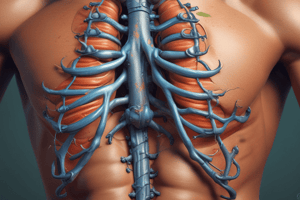Podcast
Questions and Answers
What is a ring (shackle) used for?
What is a ring (shackle) used for?
- To shackle the anchor chain to the shank of the anchor (correct)
- To hold the anchor in place
- To secure the rope
- To connect the anchor to the boat
What is the function of the shank in an anchor?
What is the function of the shank in an anchor?
It is the long center part of the anchor running between the ring and the crown.
Describe the crown of an anchor.
Describe the crown of an anchor.
It is the rounded lower section of the anchor to which the shank is secured.
What are the arms of an anchor?
What are the arms of an anchor?
What is the throat of an anchor?
What is the throat of an anchor?
What does the fluke (palm) of an anchor refer to?
What does the fluke (palm) of an anchor refer to?
What is the blade in relation to an anchor?
What is the blade in relation to an anchor?
What is the purpose of the bill (pea) of an anchor?
What is the purpose of the bill (pea) of an anchor?
What does a windlass do?
What does a windlass do?
What is the purpose of a capstan?
What is the purpose of a capstan?
What is a hawespipe?
What is a hawespipe?
What is a wildcat?
What is a wildcat?
Flashcards
Ring (Shackle)
Ring (Shackle)
The metal loop connecting the anchor chain to the shank of the anchor. It's where the anchor is attached to the chain.
Shank
Shank
The long, central part of the anchor that runs between the ring and the crown.
Crown
Crown
The rounded, lower part of the anchor where the shank is attached. It acts as the anchor's base.
Arms
Arms
Signup and view all the flashcards
Throat
Throat
Signup and view all the flashcards
Fluke (Palm)
Fluke (Palm)
Signup and view all the flashcards
Blade
Blade
Signup and view all the flashcards
Bill (Pea)
Bill (Pea)
Signup and view all the flashcards
Windlass
Windlass
Signup and view all the flashcards
Capstan
Capstan
Signup and view all the flashcards
Hawsepipe
Hawsepipe
Signup and view all the flashcards
Wildcat
Wildcat
Signup and view all the flashcards
Study Notes
Anchor Parts Overview
- Ring (Shackle): Connects the anchor chain to the anchor's shank; fixed with a riveted pin.
- Shank: The elongated central component joining the ring and crown of the anchor.
- Crown: The rounded lower segment holding the shank, designed for a pivoting motion of 30 to 45 degrees.
- Arm: Components extending from both sides of the crown, crucial for anchor stability.
- Throat: The inner curve where the arm meets the shank, providing structural integrity.
- Fluke (Palm): The broad section extending upward from the arm, aiding in anchoring efficiency.
- Blade: An extension of the arm located below the fluke, contributing to the anchor’s holding power.
- Bill (Pea): The pointed tip of the palm or fluke, assisting in penetration into the seabed.
- Windlass: A mechanical device used for managing and securing the anchor and its chain during operation.
- Capstan: A device specifically used for handling mooring lines during docking and undocking processes.
- Hawespipe: Openings located at the forefront of the ship that allow stowing of the anchor's shank.
- Wildcat: A grooved wheel in the windlass that interacts with anchor chain links, enabling the adjustment of the chain's length.
Studying That Suits You
Use AI to generate personalized quizzes and flashcards to suit your learning preferences.




